January 6, 2020 |
Randy Caparoso
Marking 10 years of lodiwine.com blogs with our 10 most revealing posts
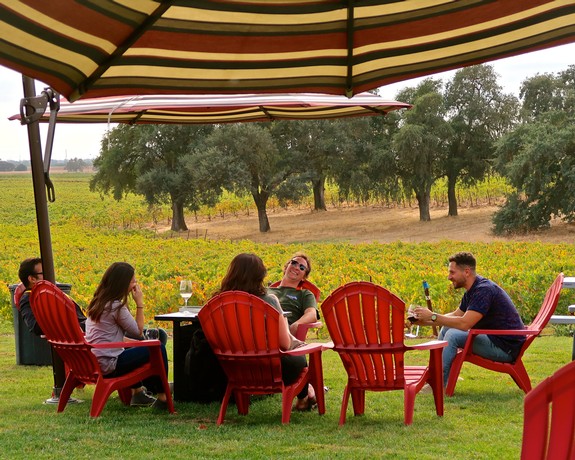
It's 2020 — good times in Lodi wine country!
Ha! — 2020 is starting to sink in. Even, if you are less than 21 years old, 2000 seems like a lifetime ago (which it was). For everyone else, 2000 seems like last week, and 2010 just yesterday.
A little less than ten years ago, in 2010, the Lodi Winegrape Commission revamped its Web site to include, for the first time, a blog page. Why? Because we could, especially since publishing tools made it much easier to get "the word" out on Lodi through the form of an entertaining yet informative "weblog." You know — wine geek stuff, but stuff anyone can grasp and appreciate. And we've been blogging ever since, once or twice a week, adding up to just over a thousand posts.
And so naturally, this fun thought has occurred: What would we consider to be our 10 "most interesting" blogs out of the thousand or so posted over the past 10 years, picking one out of each year since 2010? Scrolling through rolls, we ended up with 10 posts (actually 11, since one of them comes in two parts) that reflect an evolution of sorts in our own thinking concerning Lodi wines, grapes, vineyards, and people.
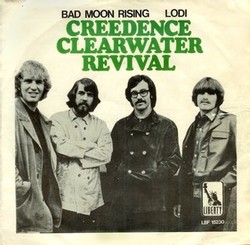 The thought process we find reflected in our chosen posts through the years:
The thought process we find reflected in our chosen posts through the years:
2010 - Our very first post — entitled Oh lord, a blog from Lodi! — which is basically a chortling about the fact that Lodi is still identified, by most Americans, as the place where Creedence Clearwater Revival's John Fogerty found himself "stuck" in a most distressful way. Ten years after, the thought occurs to us that Lodi still has a long way to go if most people still think of the song first and not the fact that this is the largest and in many ways one of the most important winegrowing regions in the western world. Keeps you humbled, and hungry.
2011 - A profile of a top-notch winemaker (Chad Joseph), who represents one of the linchpins that has played a major part in the premiumization of Lodi's winegrowing image over the past 20 years. Face it — without talent, Lodi's wine industry doesn't grow, and now we have dozens of these individuals, in vineyards and wineries, pushing Lodi's growth steadily upwards.
2012 - Our earliest detailed parsing of "east" vs. "west" side Lodi viticulture, which is absolutely not an inference that one side is "better" or even needs to be compared to the other, but rather a recognition of the simple fact that, in Lodi, the classic wine concept of terroir — or "sense of place" based upon physical growing conditions having a direct effect on resulting wines — does indeed exist, same as in other major wine regions of the world. Another linchpin in the evolving identity of a wine region.
2013 - A profile of a winery (Acquiesce) that specializes exclusively in white wines (plus one rosé), which stands as an example of two things — 1) that white wine grapes (particularly varieties naturally suited to a classically warm Mediterranean climate) are just as suitable to the Lodi Viticultural Area as red wine grapes, and 2) the future of the Lodi winegrowing industry may very well depend on capitalizing on the fact that the region is conducive to a wider variety of commercial wine grapes than other wine regions for reasons that are both economic and terroir-related. That is to say because we can.
2014 - A 2-part look back at the history of winegrowing in Lodi — something that is key to understanding how and why the region will need to move forward in its commitment to premium (as opposed to commodity) winegrowing and is also part and parcel of the phenomenal multi-generational consciousness that has driven the dramatic growth of Lodi's industry-leading LODI RULES for Sustainable Winegrowing.
2015 - Another look back at the history of Lodi agriculture — crystalized in Lodi's 1907 Tokay Carnival — with respect to its lasting impact on the culture and identity of a region's populace. It is also a graphic demonstration of the phenomenal things Lodi can do when hearts and minds are in synch (epitomized by the modern-day success of the Lodi Winegrape Commission).
2016 - A summary of the past, present and future work of the Lodi Winegrape Commission — essentially, the Lodi winegrowers themselves — while marking the organization's 25th anniversary.
2017 - A rather mournful post citing the possibility of hearing "last rites" for Lodi's "old vine" culture and identity, and where we go from here (which, notwithstanding market dictates, will probably also be in the hands of the industry itself).
2018 - A thorough rendering of Lodi's seven sub-AVAs (i.e. officially defined and regulated American Viticultural Areas) and their implementation, which will probably play an increasingly important role in the Lodi winegrowing industry's sustainability as it addresses the economic necessity of moving closer to premiumization — manifested by a quality-driven process of choosing the right grapes for the right places, cultivated in the right way.
2019 - Portraits of individuals in the Lodi winegrowing industry have taken over the past year, representing just a sampling of the thousands of people playing key roles in the formation of a "Lodi wine" identity today and in the years to come.
The selected blog posts:
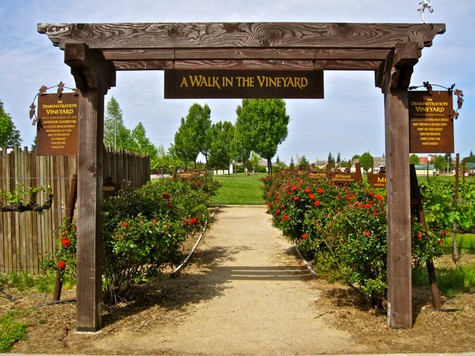
Demonstration Vineyard on the grounds of the Lodi Wine & Visitor Center
The Growing Groundswell
August 9, 2010 - By now you've heard that Lodi is more than a song (point of fact: after he wrote his famous (Stuck in) Lodi, Creedence Clearwater Revival's John Fogerty admitted he'd never visited this historic California town, but that he simply came across it and thought it had "the coolest sounding name").
Lodi is also a thriving, varied agricultural community — notably, grapes and dairy ranching, almond and walnut orchards, and cherry, olive, and myriad other stone fruits — and wine lovers from coast to coast, and even from Singapore to Stockholm, now know Lodi as the source of wines that absolutely kick your butt, without busting the budget! Read more.
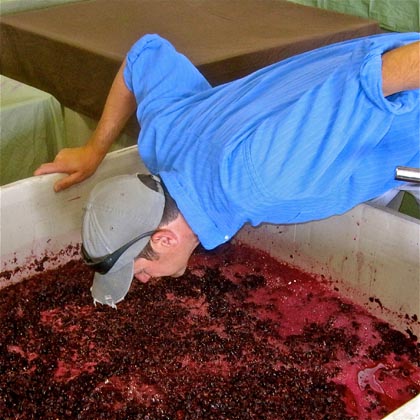
Chad Joseph utilized all his senses to evaluate fermenting 2010 Zinfandel at Harney Lane Winery
Starting off big, ending up small, resulting in big things
January 24, 2011 - In the classic old Westerns, when a small town finds itself plagued by gangs of bad hombres, they find themselves a gunslinger — someone fast on the draw, eagle-eyed with a rifle, smart as a whip, and with a heart of gold even if a little cantankerous or occasionally hooked on the bottle.
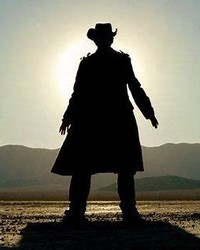 Everything except the cantankerous and gun-toting parts describes Chad Joseph. Mr. Joseph is hooked on bottles, but more as Lodi's most respected consulting winemaker than as an intemperate imbiber.
Everything except the cantankerous and gun-toting parts describes Chad Joseph. Mr. Joseph is hooked on bottles, but more as Lodi's most respected consulting winemaker than as an intemperate imbiber.
“You know what it’s like working with a million-gallon tank?” asks Joseph, talking about his first job as a winemaker, at E. & J. Gallo in Modesto. “It's a tank so big you can’t even throw a football all the way across.”
Besides miles and miles of gigantic tanks, E. & J. Gallo doesn’t just employ winemakers. They employ entire armies of winemakers, despite the benefits of automation. In the late nineties Mr. Joseph worked his way up the ranks of teams responsible for brands like Carlo Rossi, Livingston Cellars, Turning Leaf, and Gallo Sonoma; in the end, gaining valuable experience working with Gina Gallo and veteran winemakers like Marcello Monticelli.
After leaving the Gallo fold and coming to Lodi in 2001, Joseph’s winemaking career diverged onto a path going pretty much the opposite direction: from million-gallon tanks monitored and controlled by intricate computers to hand-punching fermenting wines in 120-gallon plastic macro bins with zero temperature controls or machinations. Why? “I could finally make wine!" he says, "and do things like actually hook up a pump, instead of pressing buttons on computers.” Joseph's first Lodi venture was at the micro-sized (now defunct) winery called Joseph Narcizo Wines, working with partner Patrick Costa out of the multi-winery facility called Vino Piazza (in Lockeford, a little community just east of Lodi). Read more.
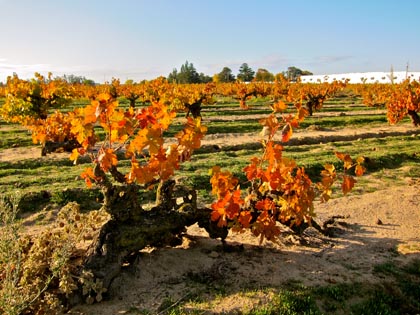
Beach blanket Zinfandel: November in Noma Ranch’s dry-farmed planting on the east side of Lodi where the soils are the sandiest and deepest
Part 2 of our autumn pain to Zinfandel (starting with Lodi Zinfandel's transitioning styles and food moxie):
November 27, 2012 - In 1991, some 600 of Lodi’s grape growers came together to form the Lodi-Woodbridge Winegrape Commission (since shortened to Lodi Winegrape Commission). At that point in time, according to the Commission’s former Executive Director, Mark Chandler, “The trade and consumers viewed Lodi as a jug wine region, despite the fact that even then we were the largest producer of premium quality wine grapes in the state, which we still are.”
Today wine bottles bearing the Lodi appellation are seen on retail shelves and fine-dining restaurant wine lists across the nation, and it is no longer a surprise when Lodi wines win double-golds and even “Best of Show” accolades in tasting competitions involving thousands of wines from other American wine regions. Read more.
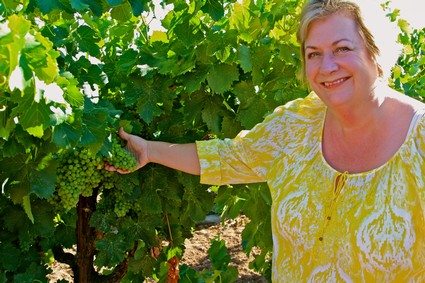
Acquiesce’s Sue Tipton with Picpoul blanc grapes grown in her Acquiesce estate vineyard
April 2, 2013 - Sometimes it’s detrimental – because nobody knows you – but sometimes it pays to be the “one and only” doing something. Talking about the Grand Tasting at the 16 Annual Rhone Rangers Celebration that took place this past March 23rd in San Francisco, Acquiesce Vineyards owner/winemaker Sue Tipton told us, “We had crowds crashing our table when word got out that we were the only ones in the room pouring a Picpoul Blanc. They were loving it, and so were we.” Read more.
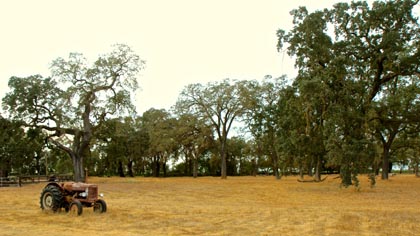
Pre-19th century Lodi: at Jessie’s Grove Winery, you can still see native grasses and ancient valley oak trees (several hundred years old) in a 32-acre grove preserved by founder Joseph Spenker and his daughter Jessie for future generations.
Mokelumne (before Lodi was Lodi)
September 22, 2014 - The first settlers of European descent arrived in the area we know as Lodi in 1846; finding what Ralph A. Clark (Lodi – Images of America) described as "an abundant paradise," perched just a few feet above sea level, sandwiched between the lower foothills of the Sierra Nevada Mountains to the east, and the lower elevation wetlands of the San Joaquin-Sacramento River Delta to the west. The Delta is the only break in the coastal mountains in the entire state of California.
The Native American tribe occupying this plush pocket just prior to the onslaught of settlers from Europe or other states was the Plains Miwok; most of whom had already succumbed to a plague that ravaged all the Native American tribes in the San Joaquin Valley in 1832.
The settlement near the banks of the Mokelumne River (mogul is a corruption of the Miwok word for river, and one means "people of") would not become known as Lodi until 1874. It was originally called Mokelumne, and officially established as a town in 1869 after a group of major landowners persuaded Central Pacific Railroad to make it a stop between Stockton and Sacramento. The site of the town's first buildings, at the corner of present-day Sacramento and Pine Streets – where the landmark Lodi Arch would later be erected (to commemorate the 1907 Tokay Carnival) – was chosen because it sits on slightly higher ground, less prone to the Mokelumne River's frequent flooding. Read more.
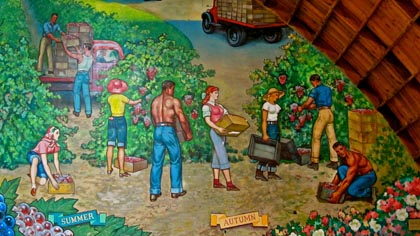
San Francisco artist John Garth’s 1960 mural in the Lodi Grape Festival hall, depicts the Lodi seasons of yesteryear.
Turn of the century rise of Lodi wineries and growers’ cooperatives
September 23, 2014 - In 1900 Urgon Winery was founded by an enterprising German emigrant named Adolph Bauer, who recognized the need for a wine production facility at a time, during the late 1890s, when many Lodi farmers were transitioning from watermelons to grapes. With the help of his partner John Guggolz, Bauer established the first independent facility for wine and brandy production in the Lodi region. Prior to that, Lodi growers were forced to sell most of their grapes to El Pinal Winery – later re-incorporated as George West and Son Winery – located further south in Stockton.
Urgon Winery reportedly paid growers as much as $22-$23 per ton for their grapes; operating out of two facilities – one at Stockton and Pine Streets in the town of Lodi, and the other a mile north of Lodi, in present-day Acampo (along Woodbridge Rd.). Not to be undone, however, George West and Son Winery acquired Bauer and Guggolz’s two wineries in 1904, and grape prices dropped back down to as low as $3.50 per ton. Read more.
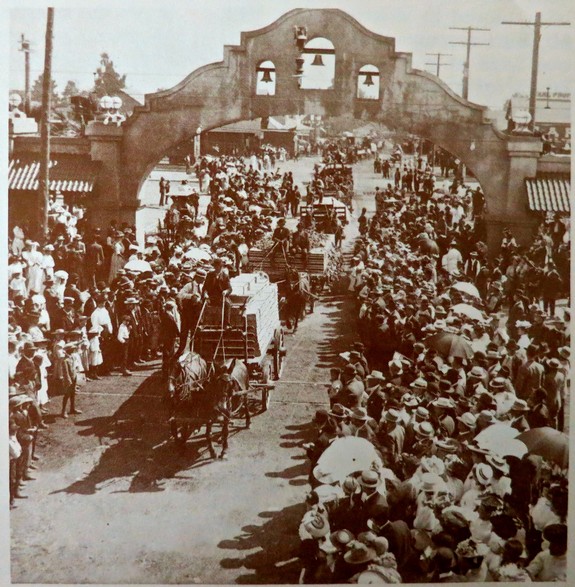
Start of the mile-long procession of Tokay grape-laden wagons triumphantly entering Lodi at the 1907 Tokay Carnival
October 27, 2015 - Lodi enjoys a glorious, oft-times phenomenal, past. This especially goes for what occurred 108 years ago; a time when things were looking really, really good for this burgeoning table and wine grape region.
According to the Lodi Historical Society’s Lodi Historian newsletter (Fall 1990), in 1907...
The grape had replaced the watermelon. The town had just become incorporated (in 1906). Tracks for a new passenger railroad were being laid between Stockton and the 2,000 inhabitants of this proud city. It was spring and the disastrous flood of 1907 had receded...
Charles Ray (a local businessman) put forth the idea of advertising the beauty and value of the Tokay grape by having a large carnival which would make the entire central portion of the state, if not the world, sit up and take notice... Read more.
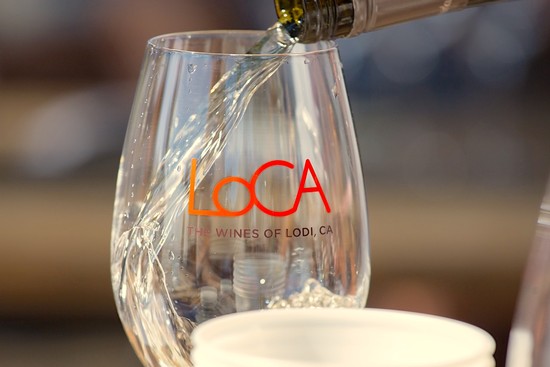
(photo courtesy of John Curley Photography)
July 14, 2016 - Lodi is, like, weird. That is to say, this sprawling wine region (by far the largest in the U.S., with over 100,000 acres of planted wine grapes, and counting...) is led by an organization of grape growers and wineries collectively known as the Lodi Winegrape Commission.
Pursuant to the State of California Department of Food & Agriculture's Marketing Act of 1937, winegrape commissions are funded by annual assessments of the gross value of winegrape crops. In the case of Lodi, every commercial grape grower within California Grape Crush District 11 is compelled to join. While mandated programs like this are not a choice thing, each grower recognizes the shared benefits of marketing and promotion of the region’s grapes, the viticultural research and sustainable grape growing (i.e. Lodi Rules) programs, exposure of wines and the region as a destination through aggressive media and consumer campaigns, and ultimately, profitability for all. Read more.
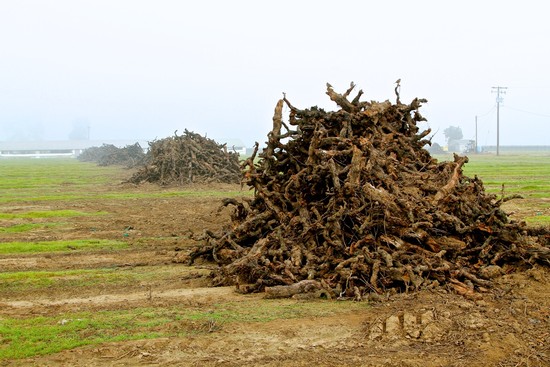
Typical fall scene in Lodi wine country: another old vine vineyard bites the dust
The Phillips Family Issues Dire Warnings
September 15, 2017 - Imagine a Lodi without old vine Zinfandel. It’s not an impossibility.
This issue always comes up in years when yields are down, as they were in 2017, 15%, 25%, or even more than 50%. This time around it comes in the middle of an economic cluster fudge: Sales of $10-and-under varietal Zinfandel continue to drop, winery supplies of fermented juice are backed up to the hilt, and White Zinfandel is no longer setting the wine world on fire (hasn’t for a while).
So right now, the question for many Lodi growers still sitting on old, gnarly, head-rained, spur-pruned Zinfandel planted prior to 1967 – the Historic Vineyard Society defines “old vines” as anything over 50 years old – is, why bother?
Why not pull out the old vines that aren’t turning a sufficient profit, and replant with higher yielding varieties selling for far more or at least are in much bigger demand (currently, for instance, grapes like Cabernet Sauvignon, Petite Sirah, and even Sauvignon blanc fit the bill better), and be done with it? To heck with old Vine Zinfandel. Read more.
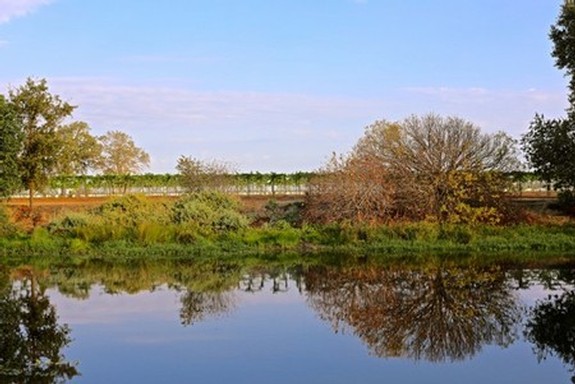
Beautifully restored riparian environment showing classic San Joaquin Series soil (a clay alluvium, and also the official state soil of California) in LangeTwins Family Vineyards' Jahant AVA estate
Why subdivide a region into smaller AVAs?
October 18, 2018 - In August 2006, when the TTB (Alcohol and Tobacco Tax and Trade Bureau) approved the usage of seven new American Viticultural Areas (a.k.a. AVAs) within the broader Lodi AVA (originally established in 1986), the question in the minds of a lot of people among the wine industry, the media, and consumers was: why?
Isn’t getting anyone to recognize Lodi as an existing wine region hard enough, without complicating the matter with seven more sub-regions?
The question is legitimate. Then again, so is the answer – the reasons for establishing the Lodi sub-appellations even if, in the beginning, they are unfamiliar to just about everyone outside the growers who actually work these vineyards.
The first reason is historical: Because the best and most recognizable wine regions in the world are all defined by multiple appellations based upon differences, from subtle to drastic, in climate, soil, topography, etc. Read more.
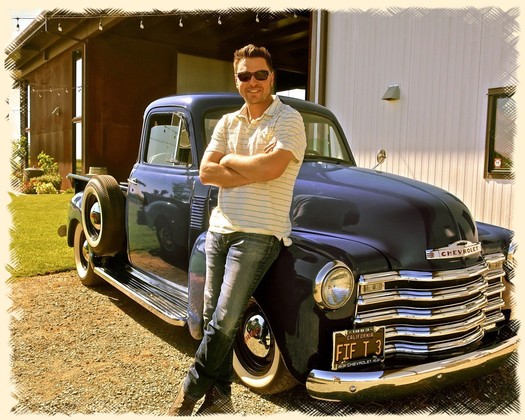
Third generation Lodi grower Ben Kolber (KG Vineyard Management) with his beloved old Chevy during a LODI RULES for Sustainable Winegrowing gathering this past spring at m2 Wines winery
December 21, 2019 - The French word for wine producer is vigneron. There is no real translation for it, but it refers to a person who grows grapes and turns them into wine, based upon an assumption that this person is always one and the same, both farmer and winemaker.
In that sense, vigneron sort of means "winegrower," inferring that wine is not so much made as it is grown, like any other agricultural product. That describes the Lodi Viticultural Area perfectly: America's largest winegrowing region, where wine-grape growers are the dominant force, and winemakers and wineries are an extension of that industry.
Sometimes it takes an "outside" observer to elucidate the meaning of that. In the most recent issue of a nationally read wine trade magazine called The SOMM Journal (December 2019/January 2020), a restaurant sommelier from Austin, Texas penned a nice, little article on her visit to Lodi last summer, entitled Why Lodi? According to the author Krista Church, when colleagues learned that she was visiting Lodi they asked: "Why Lodi? I understood their incredulity... I don't know what I expected when I arrived, but I know that the actual experience defied anything I could have imagined." Read more.


 The thought process we find reflected in our chosen posts through the years:
The thought process we find reflected in our chosen posts through the years:
 Everything except the cantankerous and gun-toting parts describes Chad Joseph. Mr. Joseph is hooked on bottles, but more as Lodi's most respected consulting winemaker than as an intemperate imbiber.
Everything except the cantankerous and gun-toting parts describes Chad Joseph. Mr. Joseph is hooked on bottles, but more as Lodi's most respected consulting winemaker than as an intemperate imbiber.







